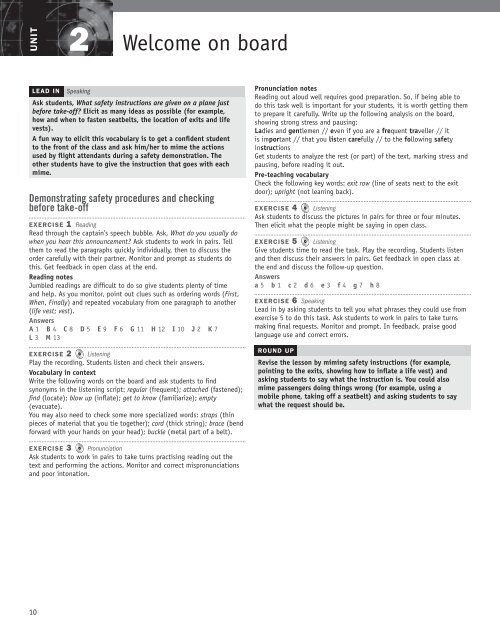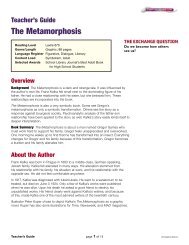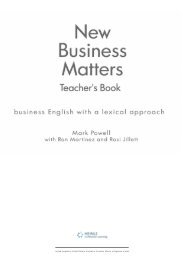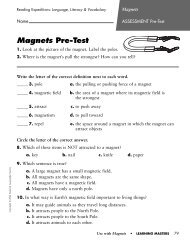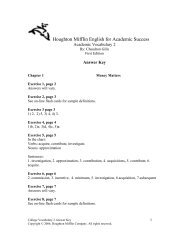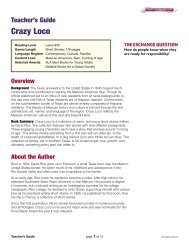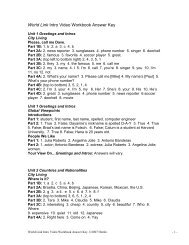English for Cabin Crew Trainer's Guide - Heinle
English for Cabin Crew Trainer's Guide - Heinle
English for Cabin Crew Trainer's Guide - Heinle
Create successful ePaper yourself
Turn your PDF publications into a flip-book with our unique Google optimized e-Paper software.
UNIT<br />
2 Welcome on board<br />
LEAD IN Speaking<br />
Ask students, What safety instructions are given on a plane just<br />
be<strong>for</strong>e take-off? Elicit as many ideas as possible (<strong>for</strong> example,<br />
how and when to fasten seatbelts, the location of exits and life<br />
vests).<br />
A fun way to elicit this vocabulary is to get a confi dent student<br />
to the front of the class and ask him/her to mime the actions<br />
used by fl ight attendants during a safety demonstration. The<br />
other students have to give the instruction that goes with each<br />
mime.<br />
Demonstrating safety procedures and checking<br />
be<strong>for</strong>e take-off<br />
EXERCISE 1 Reading<br />
Read through the captain’s speech bubble. Ask, What do you usually do<br />
when you hear this announcement? Ask students to work in pairs. Tell<br />
them to read the paragraphs quickly individually, then to discuss the<br />
order carefully with their partner. Monitor and prompt as students do<br />
this. Get feedback in open class at the end.<br />
Reading notes<br />
Jumbled readings are diffi cult to do so give students plenty of time<br />
and help. As you monitor, point out clues such as ordering words (First,<br />
When, Finally) and repeated vocabulary from one paragraph to another<br />
(life vest; vest).<br />
Answers<br />
A 1 B 4 C 8 D 5 E 9 F 6 G 11 H 12 I 10 J 2 K 7<br />
L 3 M 13<br />
EXERCISE 2 Listening<br />
Play the recording. Students listen and check their answers.<br />
Vocabulary in context<br />
Write the following words on the board and ask students to fi nd<br />
synonyms in the listening script: regular (frequent); attached (fastened);<br />
fi nd (locate); blow up (infl ate); get to know (familiarize); empty<br />
(evacuate).<br />
You may also need to check some more specialized words: straps (thin<br />
pieces of material that you tie together); cord (thick string); brace (bend<br />
<strong>for</strong>ward with your hands on your head); buckle (metal part of a belt).<br />
EXERCISE 3 Pronunciation<br />
Ask students to work in pairs to take turns practising reading out the<br />
text and per<strong>for</strong>ming the actions. Monitor and correct mispronunciations<br />
and poor intonation.<br />
10<br />
Pronunciation notes<br />
Reading out aloud well requires good preparation. So, if being able to<br />
do this task well is important <strong>for</strong> your students, it is worth getting them<br />
to prepare it carefully. Write up the following analysis on the board,<br />
showing strong stress and pausing:<br />
Ladies and gentlemen // even if you are a frequent traveller // it<br />
is important // that you listen carefully // to the following safety<br />
instructions<br />
Get students to analyze the rest (or part) of the text, marking stress and<br />
pausing, be<strong>for</strong>e reading it out.<br />
Pre-teaching vocabulary<br />
Check the following key words: exit row (line of seats next to the exit<br />
door); upright (not leaning back).<br />
EXERCISE 4 Listening<br />
Ask students to discuss the pictures in pairs <strong>for</strong> three or four minutes.<br />
Then elicit what the people might be saying in open class.<br />
EXERCISE 5 Listening<br />
Give students time to read the task. Play the recording. Students listen<br />
and then discuss their answers in pairs. Get feedback in open class at<br />
the end and discuss the follow-up question.<br />
Answers<br />
a 5 b 1 c 2 d 6 e 3 f 4 g 7 h 8<br />
EXERCISE 6 Speaking<br />
Lead in by asking students to tell you what phrases they could use from<br />
exercise 5 to do this task. Ask students to work in pairs to take turns<br />
making fi nal requests. Monitor and prompt. In feedback, praise good<br />
language use and correct errors.<br />
ROUND UP<br />
Revise the lesson by miming safety instructions (<strong>for</strong> example,<br />
pointing to the exits, showing how to infl ate a life vest) and<br />
asking students to say what the instruction is. You could also<br />
mime passengers doing things wrong (<strong>for</strong> example, using a<br />
mobile phone, taking off a seatbelt) and asking students to say<br />
what the request should be.


